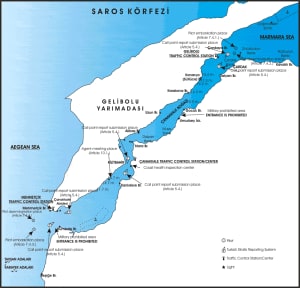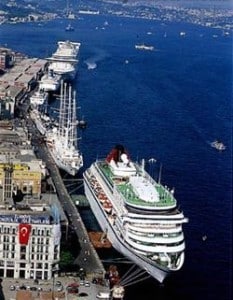 Captain Albert Schoonderbeek
Captain Albert Schoonderbeek
The Dardanelles are of course in Turkey but to get there you have to sail through the Greek islands. Some of those islands are much closer to Turkey than they are to Greece. On the west of an island it might be 10 miles away from the nearest other Greek island but less then a mile away from the Turkish mainland coast. As there is sometimes a bit of friction between Greece and Turkey, just think about the Cyprus issue, it is amazing to see how much the two countries are intertwined as far as their border is concerned and how well it all works. At least for us. Thus we made our way towards the Dardanelles by sailing around several Greek islands to get here.
To make the schedule to Istanbul on time, I had to go through the Dardanelles fairly early otherwise I would have been late in Istanbul. However by doing the first leg a bit slower and by going after the passage full out, the ship could pass the entrance at sunrise and do the complete passage at daylight. The guests will be able to see the passage on the way down at a more decent time but the early birds had the option for an early morning view as well now. Pilotage is not compulsory for every ship that goes through but for certain ships it is and for others it is highly recommend by the authorities who are very eager to have as few collisions and other mayhem as possible. I always take a pilot at the Dardanelles not because I am not capable of doing it myself but because the Dutch law requires it.
We have an article in the Dutch law in the Code of Commerce, which spells out when a captain of a Dutch flagged ship should take a pilot. A. when it is compulsory (that is simple, local law requires it) B. when it is customary (if a pilot station has four boats and 75 pilots for an area, that is definitely customary) and C. where carefulness (read good seamanship) requires it. In this case rule two applied; there is a very elaborate pilot system in the Dardanelles, so we took a pilot. Main reason is the language barrier, as a lot of Turkish ships do not take a pilot and do not speak English either.

The Dardanelles with the pilot stations and the VTS calling in points which regulate traffic in the passage. Diagram, courtesy of Turkish Pilots.
So we picked up the pilot right under the Turkish First World War monument and sailed with the maximum, but sedate speed of 15 knots, through this gap in the mountains. To my utter amazement there was at certain times almost a 2.5 knot current running against us. There is no tide difference in this area but the difference in density in the waters between the Med and the Black Sea and the fact that rain water entering the Black Sea has to go somewhere eventually, creates a flow through the Bosporus and the Dardanelles. So I knew there was a water flow but 2.5 knots at the most narrow part (Kilit Bahir) that I had not expected.
With this current against us and the maximum speed of 15 knots allowed it took us until 08.40 before I could disembark the pilot and put the pedal to the metal for getting on time to Istanbul. The Sea of Marmara which connects the Dardanelles with the Bosporus is not that wide to be considered a real sea but it is certainly deep. 1500 feet under the keel was not unusual while we sped through the waters, overtaking smaller ships left right and centre. Just after 2 pm. we had the pilot onboard and the Prinsendam approached the port of Istanbul. As the sun was brightly shining (and behind us) we had a glorious look at old Byzantium and the Aga Sophia while we neared the dock. Alongside was already the Minerva from Swan Hellenic and we were put all the way forward as tomorrow “A bigge- boate” was expected. One of the Costa Mega liners was coming for a day call.

The passenger dock in Istanbul. An old photo showing Cunard's Seabourn Sun, now the Prinsendam, docked alongside. For this call we were at the end at the top of the photo.
Docking at Istanbul passenger terminal takes a bit of patience due to the currents running in the corner where the old port called Karakoy is located. First you get pushed towards the rocks and away from the dock with a current running out of the Bosporus and when about 20 meters away from the dock you suddenly shoot forward pushed by a counter current. So gently, gently is the word. For this reason (and the fact that they do not like damage to their docks) the port authorities have made tug boat assistance compulsory. And if I have to pay for tugs, then I use them. So with a 5500 hp. tugboat hanging at the stern we docked at Salipazari berth 1 – 2. in the Europe side of Istanbul.
We will stay overnight here for the evening tours and be in port tomorrow all day until 23.00 hrs. As I am blessed with the biggest captain’s cabin afloat (it doubles as a public room for parties with a capacity of about 60 guests) I am not going ashore but am going to enjoy dinner on my balcony overlooking the Bosporus. The life of a cruise ship captain has it perks now and then.
To access Captain Albert’s historical writings on Holland America Line as well as photos and additional information about Prinsendam and his sailing schedule, click here.

Leave a Reply